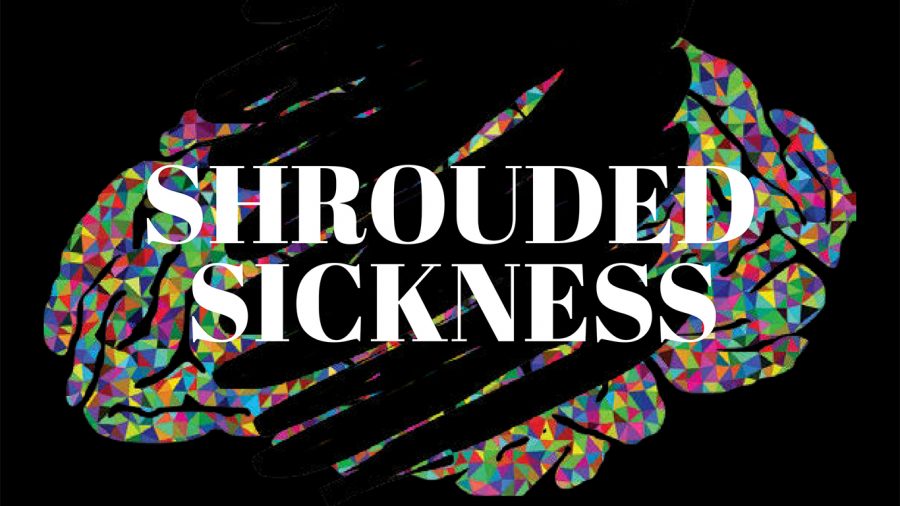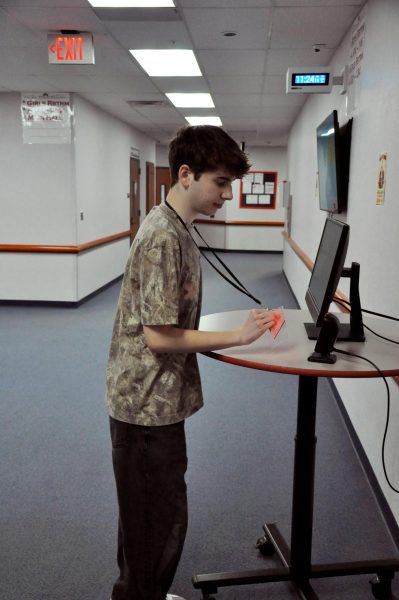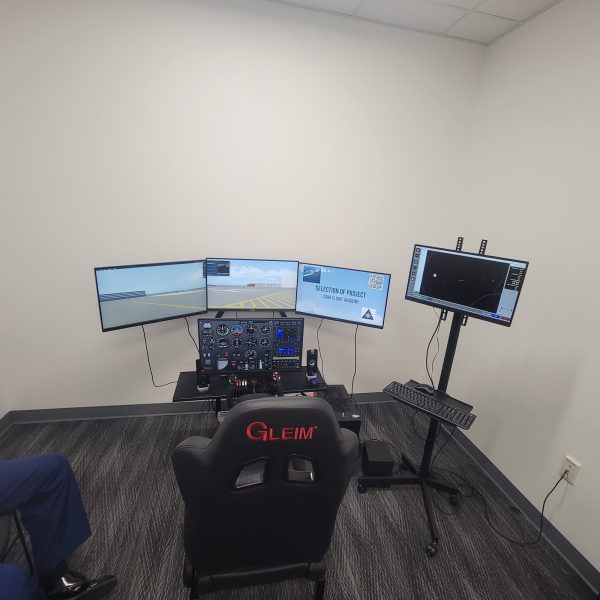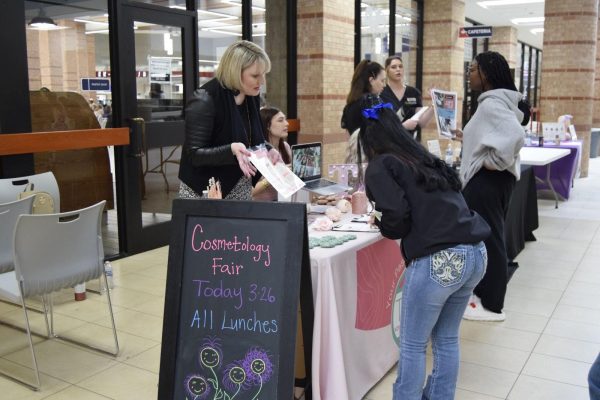Shrouded sickness
Understanding mental illness, its impact on Allen High School and why the stigma behind speaking up can worsen an already grave problem.
On some days, Makayla Nerpel felt invincible. She could conquer the world, she could take the earth by storm and nothing would be able to stop her. She was productive. She was outgoing. No matter where she was or what she was doing, she was buzzing with drive and ambition.
On other days, Makayla couldn’t get out of bed. The shower was just so far away. The schoolwork she knew she had to do could wait a day or two. A month or so. A year, give or take. The idea of pulling herself from the comfort of her sheets and comforter, throwing herself through the trials of the day to come, only sunk her deeper into depression.
“I felt like I was crazy because no one else seemed to be having the problems that I was having,” Nerpel said.
Nerpel, an Allen High School alumna, struggled with mental illness throughout high school. Her diagnoses included bipolar disorder I, borderline personality disorder and post-traumatic stress disorder (PTSD). And she is far from alone.
According to a Nov. 29 poll of 150 students conducted at Allen High School by the Eagle Angle’s staff and editors, 1/5 students have a mental illness, and 11/15 know someone who has one. Furthermore, 23/30 believe those who are diagnosed with a mental disorder have a stigma attached to their condition. Mental illness is not hypothetical or unverified, it is undeniably a real problem. The questions that need answers are: why are these students affected by these conditions? How does it impact them? And what can the community — and on a larger level, society — do to resolve the issues involved with how we talk about mental illness?
The root of the problem
Dr. Shahla Ali, a board certified psychiatrist based in Allen, said that mental illness in adolescents has no single source and no single symptom. There are, however, common threads between many teenagers who are affected. She said there are a few disorders that are among the most common diagnoses.
“In adolescents, the most common ones these days — and they’re constantly increasing in intensity — is depression, anxiety and to some extent, OCD,” Ali said. “Depression is the most common one. I would say I have never seen such a high ratio of adolescents, especially in this area in Allen, Plano. I see kids from Allen High, I see kids from McKinney Boyd, Frisco, you name it.”
Mental disorders are holistic in nature. Ali said that some ailments can lead to the flare up of others, snowballing into more problems than initially seen.
“A second common one would be anxiety, and anxiety and depression go hand in hand,” Ali said. “Sometimes I see kids who have anxiety first; and they were so anxious that it debilitated them to a point where they became depressed. So I see both of them.”
Nerpel said that her own experience with mental illness is similar, and her diagnosis with bipolar I and borderline personality disorder were concurrent and intertwined. However, the road forks when it comes to possible remedies.
“Bipolar I and borderline kind of go hand in hand because they’re both centered around very drastic mood swings,” Nerpel said. “But the treatment is a lot different. Borderline can’t be treated with medicine as well as bipolar disorder can.”
According to Ali, both a prescription for the disorder and therapy are necessary in treating mental disorders. However, parents sometimes are uneager to put their children on medication.
“I’ve seen it many times, parents will not accept or agree with the treatment,” Ali said. “There is a common misconception out there that, once you start taking antidepressants, you have to take them for the rest of your life, they’re habit-forming, they’re very dangerous; stuff like that. They are reading the blogs, but they aren’t consulting the experts. So my first job is to educate them.”
According to Ali, there is often something in the teen’s life that has led to the onset of depression or anxiety, whether it be from school or home.
“Most of the time there is something,” Ali said. “They are being bullied, they are very reluctant to tell me what’s going on at home. Recently, I have also seen this trend where in a few cases, the kids — especially the teenagers — they are not sure about their gender. So they were transgender, and they were so reluctant to share that with their parents. I could see that by reading them in the first meeting, and somehow, their parents missed that.
The time of the year also has an effect on the rate of depression. Ali said that for her practice, November and December are the worst months for depression for people with seasonal affective disorder.
“There are people that are OK throughout the year, but this month is darkness, these days without sunlight,” Ali said. “It is not just my impression or my personal opinion, it’s the national data. Last year, total number of suicides just in the month of November had surpassed the amounts throughout the year. So it’s the same every year.”
With the complexity of each mental disorder and their symptoms, students need to know exactly what they have, what they will experience and how to get help. Jennifer Atencio, AHS crisis counselor, recommends coming to a counselor in order to address issues that arise in all aspects of life.
“Some students check WebMD — and I don’t encourage that — and they try to self-diagnose by doing research online, or talking to friends that they know have been diagnosed,” Atencio said. “That may be one place to start, but I encourage them to come to their counselor or to me. We can not only address the concerns of a student in a school setting, but outside of school as well.”
Every morning, every night
According to Ali, mental illness can encompass every aspect of an adolescent’s waking hours, from their schoolwork to their social life.
“Oh, it impacts their lives,” Ali said. “There is an image of professionalism, you have to look perfect physically, and your grades. I see that kids are very competitive, if their grades are a little bit less, I see them start worrying about it. Even if they don’t go to advanced classes, they worry about it.”
Senior Hallie Platt said she endures the difficulties of PTSD, anxiety and manic-depression, and she believes it definitely impacts her academics.
“If I was in a particularly low depression, I still had to go to school,” Platt said. “I’d go into the bathroom and cry because there’s nothing else to do. I can’t control it. I’d go home, and I’d sit there and stare at my work and not know what to do. Being anxious about work overwhelms you to the point where you can’t actually do that work. And depression, overall, just makes it difficult to do anything active at all.”
Nerpel said the mania and depression associated with bipolar disorder made it difficult for her to function like an ordinary student would.
“School was stressful because I would have those really depressive days where everything felt like such a chore,” Nerpel said. “Getting out of bed, taking a shower, everything felt impossible to accomplish. But, on the other side, when I had manic days, I felt untouchable. And while that was a good feeling, the bad side of it was that I was able to do what I needed to do, but I wasn’t able to finish it. I was scatterbrained, I was jumping around from thing to thing.”
According to Ali, the knee-jerk response to testimonies like Platt’s and Nerpel’s is to just keep swimming, to continue the climb until you get to the top, but Ali claims it’s not that simple.
“A lot of times they are told by society, ‘just get over it,’” Ali said. “‘Just get over your depression. Just get over your anxiety.’ So I want to tell all those kids that have that stigma and they’re reluctant to go to a psychiatrist that please know, depression or anxiety, they’re just like any other medical problem. Just like you can not tell somebody with high blood pressure that they need to just get over it, or someone with a fractured arm to just get over it. This is a medical problem and unless you treat it, it’s not going to go away on its own.”
Nerpel said she agrees. Earlier this year, after struggling to accept help from her friends, family and a psychiatrist — she said she struggled seeing one without a therapist for emotional support — , Nerpel said she attempted suicide. However, she stepped back upon hearing her fiancé come home, and asked to go to the hospital. She spent a week working on herself in inpatient care, and says the fact that she pulled herself away and chose to survive has changed her outlook on her disorders.
“I think the most important part s now that I’ve been at the edge, and I could’ve ended it, and I chose not to, I know it’s possible now,” Nerpel said. “I know it’s possible to get better. And I’m hopeful for the first time in a really long time. It’s a battle, but once you take that first step and you realize ‘this isn’t all in my head, there is something wrong with me, medically, and I can get help for it,’ you understand more that, yes, it is a big battle and you have to do it for the rest of your life, but there are things that make it worth it. And you just have to find those things.”
Atencio said that one of the most important measures to take in assisting students with mental illness is to talk to a trusted adult or a medical professional as soon as possible, and that waiting to take action only worsens the issue.
“On average, [the time] from first symptom to actual diagnosis, is nine years,” Atencio said. “Oftentimes — using depression as an example — they will tell me, ‘I started feeling depressed in fifth grade.’ And they’re sitting on my couch as a junior. So, I try to encourage parents to see that if you can get these things addressed, their mood will improve, and there’s a correlation with academics. Their work will also improve, they will feel motivated to get work done.”
Platt discussed her experience with mental illness using a similar sentiment to Ali: mental health is just as important as one’s physical well-being.
“A mental illness is just as severe, if not more severe, than a physical injury,” Platt said. “Because, with physical illnesses, you take medicine for that. You go to a doctor. Why aren’t people doing the same thing with mental illnesses? The brain is such a sensitive thing, it’s so delicate, and if you have a chemical imbalance, that needs to be fixed for you to have the life that you want to live. Talk to counselors. Talk to therapists. Talk to your doctor about what you’re going through. It can be helped.”
Stopping the stigma
However, according to Ali, getting help for mental disorders is not easy because of the stigma associated with it. She emphasizes that people are sometimes ashamed of their illness enough to seek help far from where they live.
“It’s not easy to talk to someone about their most personal stuff, so that is one reason why they are so reluctant to come and get help for that, and they don’t want anybody to know,” Ali said. “I get patients from Houston and Sherman and far-off areas because they don’t want to go to a local psychiatrist over there. They’re afraid that it’s going to be known.”
With students in particular, Atencio says one issue is a teenager’s fear that they may not be heard by their parents. She urges parents to approach the situation with a compassion and an open mind.
“I would try to get parents to understand that if you can get this one issue addressed, so many others will be resolved,” Atencio said. “Your child will be more engaged in learning. Ultimately, parents want their children to be happy, and when you have a child who is clearly unhappy, let’s fix it. These are largely treatable illnesses, so why not treat it and ease your child’s suffering?”
Ali echoed Atencio’s sentiment, praising those with mental illness for their bravery. She disagrees with the societal connotation of mental illness, believing those who are affected are courageous, not cowards.
“Mental illness and asking for help is not a sign of weakness, it is a sign of great courage and strength to come forward and say, ‘I need help,’” Ali said. “Psychological pain is worse than physical pain. So if there is one thing I want to tell them, I want to tell them, you are very brave. What you are dealing with is not easy. It’s a very brave thing to do. It is not a sign of weakness. So come forward, and maybe once you get better, join me and join others who are in this field and help.”
Platt emphasized the importance of self-care, claiming that keeping yourself healthy is a crucial step in getting better.
“I know school makes us all really busy, but in the time that you have, take care of yourself,” Platt said. “Take care of your body. Because, even though you might be really anxious or really depressed, you might not want to eat, but you have to eat. You have to take showers. These things are so important, and they help you feel better. Taking care of your body is so important, and so is taking care of your mind. Relaxation, giving yourself time to breathe is so important.”
Nerpel said she knows that teens like her with mental illness may find it hard to do these simple things as well as find a will to live, but she promotes finding ways to feel happy despite the struggle, the impacts and the stigma of mental disorders.
“There is a way that you can enjoy life again,” Nerpel said. “You may not want to live right now, but in my opinion, it’s not that you don’t want to live right now. It’s that you don’t want to live like this. So you have to kind of find the way that you do want to live. I’ve got mine. And I am relatively happy. And it’s only going up from here.”

Senior Felix Kalvesmaki likes mangoes, true crime and the band Bleachers. He plans on going to NYU to study journalism and music production.

Senior Maya Morriswala enjoys listening to music, playing piano and writing everything from piano solos to orchestral compositions. She plans to go to...












